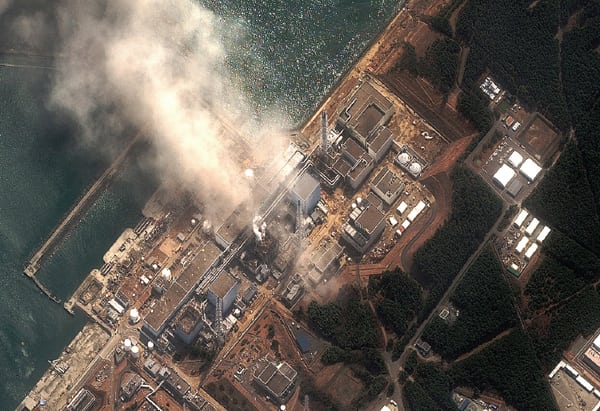The Battle to Control Quake-Stricken Japanese Reactors
As POWER closes this issue (March 15), 6,000 people have been confirmed dead and 10,000 others are still missing as a result of the magnitude 9.0 earthquake and ensuing tsunami that destroyed Japan’s eastern shore on March 11. At this writing, the country is battling a third cataclysm—the potential meltdown of several reactors at Tokyo Electric Power Co. (TEPCO’s) Daiichi nuclear power plant in Fukushima Prefecture.
While the quake triggered an automatic shutdown of five of the plant’s six reactors, it also knocked out power needed to drive cooling systems. The tsunami deluged the facility’s diesel-powered backup generators, causing them to fail. As of March 15, the plant has already experienced three explosions—at Units 1, 2, and 3—plus a hazardous fire at Unit 4. Efforts to inject seawater and boric acid into the reactors continue—as do urgent measures to douse a fire at Daiichi 4. Authorities are also watching Daiichi 5 and 6 for complications.
Experts explained that as the fuel temperature increased to 1,800F, a chemical reaction between the metal cladding of the fuel rods and the steam flowing past them would generate large quantities of hydrogen. This hydrogen could have leaked from the reactor vessel—though crews desperately tried to vent pressure—and exploded, leaving both Units 1 and 3 without an intact containment.
The explosion of Unit 2 on March 14 was more serious: After cooling systems for the reactor failed after the quake, workers were unable to fill the reactor vessel with seawater, owing to a valve cap “that automatically closed.” Japanese public broadcasting network NHK World reported that calamity could have fully exposed fuel rods inside for up to six hours.
The blast heard near the donut-shaped suppression pool damaged the containment, TEPCO reported. Radiation after the blast at the facility spiked to nearly 400 millisieverts (about 20 times the average annual nuclear worker’s exposure), Chief Cabinet Secretary Yukio Edano said at a press conference. He added that he could not rule out the possibility of a meltdown at all of the plant’s three troubled reactors.
The event has been classified as a level 4 on the 0 to 7 International Nuclear and Radiological Event Scale (INES), though international watchdogs, which have criticized the government for its slow release of information, rate it a 6.
Some 200,000 people living within a 12.4-mile (20 kilometer) radius of the plant have been evacuated, and those within a 30-mile radius were advised to “stay indoors.” About 50 workers remain at the Daiichi site, “trying everything” to control overheating fuel rods at three units (1, 2, and 3) and suppress the ever-more-perilous threat of meltdown and widespread radiation, as Japan’s Prime Minister Naoto Kan has told the nation.
There have been some triumphs: Though emergencies were declared on March 11 at nearby nuclear power plants—the Fukushima Daini, Onagawa, and Tokai—authorities say all units of those plants are under control and in cold shutdown.
But woes for the country’s power sector are only set to get worse. Eleven of Japan’s 54 reactors are off-line—including the 4.7-GW Daiichi—and TEPCO has suspended operations at five thermal power plants. According to the economy, trade, and industry minister, a power shortfall of 10 GW means utilities will be forced to institute rolling blackouts that could last several weeks. To secure future power supplies, Japan must return to non-nuclear generation—particularly thermal power—Mikio Kitada, a former Kansai Electric Power Co., told The Japan Times.
 |
| 1. Blast at Japanese nuclear plant. In this satellite image taken Mar. 14, 2011, the No. 3 nuclear reactor of the Fukushima Daiichi nuclear plant is seen burning after a blast following an earthquake and tsunami that killed at least 10,000 people. The Fukushima nuclear complex is 240 km (150 miles) north of Tokyo. Courtesy: DIGITAL GLOBE REUTERS/Digital Globe/Handout |
It is important to note that actual conditions at affected Daiichi units are unknown—and probably will not be fully revealed for decades, as with the 1979 Three Mile Island partial meltdown—said Robert Alvarez, a former senior policy adviser for the U.S. Department of Energy and scholar at the Institute for Policy Studies, at a March 14 press conference. Peter Bradford, a former commissioner of the U.S. Nuclear Regulatory Commission and member of the five-expert panel at that same press conference, agreed. He said all that could be inferred was that the event posed the “gravest danger,” judging from urgent calls for evacuation—something “no government would do if they could help it” right after the cataclysm of earthquake and tsunami.
Another expert, Ken Bergeron, physicist and former Sandia National Laboratory scientist, who worked on nuclear reactor accident simulation, predicted that the crisis could be much worse than the 1986 Chernobyl nuclear power plant accident in the Ukraine—the only event classified as an INES level 7. One reason is that the Chernobyl accident resulted in a greater release, but it was “into the stratosphere far away from populations.” If a release occurs in Japan, he said, “all radioactive material is going to be right on the surface of the earth and much more available to expose populations.”
Experts also ominously noted repeatedly that five of the six Daiichi reactors are GE Mark I boiling water reactors—the same used by 23 of the 104 U.S. reactors, most of which were constructed in the same timeframe.
Another repeated concern was that mixed plutonium and uranium oxides (MOX) fuel made up about 6% of the Daiichi 3 core. “MOX fuel generally worsens the consequences of severe accidents in which a large amount of radioactive gas and aerosol is released compared with non-MOX uranium fuel because MOX fuel contains greater amounts of plutonium and other actinides, which are highly toxic,” as Union of Concerned Scientist senior scientist Ed Lyman blogged.
—Sonal Patel is POWER’s senior writer.